Assessment 2: Marketing Plan Project for Metro Hotels - Report
VerifiedAdded on 2022/09/16
|20
|5789
|15
Report
AI Summary
This report details a marketing plan for Metro Hotels, an Australian hospitality company. It begins with an internal and external environment analysis, examining core activities, business performance, market growth, industry trends, and legal constraints. The report then outlines a marketing strategy, including product and service opportunities, innovative marketing techniques, and distribution channels. It emphasizes legal, ethical, and sustainability considerations, along with stakeholder consultation. The marketing plan section details methodologies, individual contributions, and monitoring and evaluation processes, including benchmarks and timeframes. The implementation strategy covers scheduling, data collection, and communication. The report concludes with a summary of the research process, information analysis, and key aspects of the marketing strategy, highlighting the importance of effective communication and evaluation for the plan's success. The plan aims to attract new customers and retain existing ones, adapting to changing market requirements and incorporating industry trends like IoT and AI.
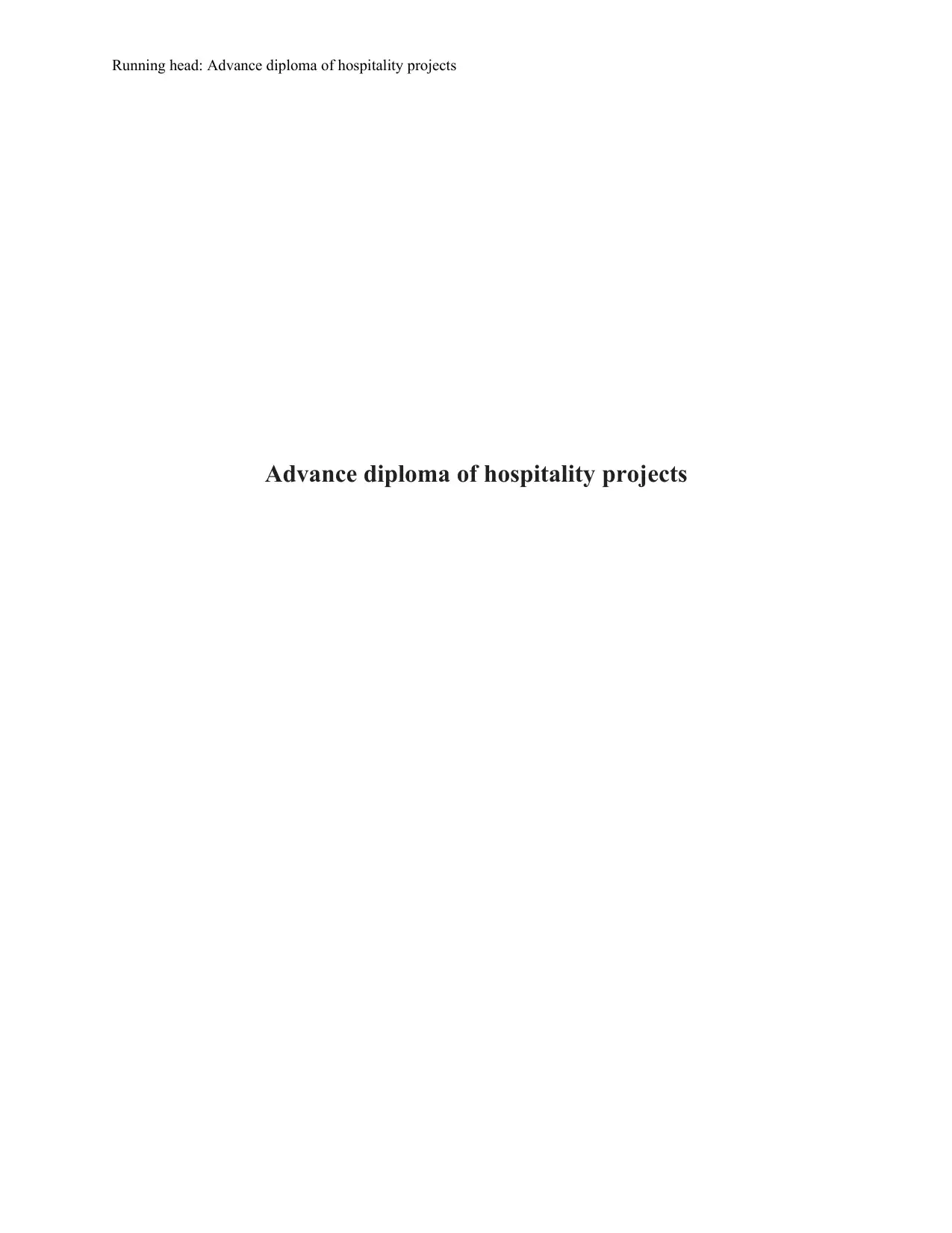
Running head: Advance diploma of hospitality projects
Advance diploma of hospitality projects
Advance diploma of hospitality projects
Paraphrase This Document
Need a fresh take? Get an instant paraphrase of this document with our AI Paraphraser
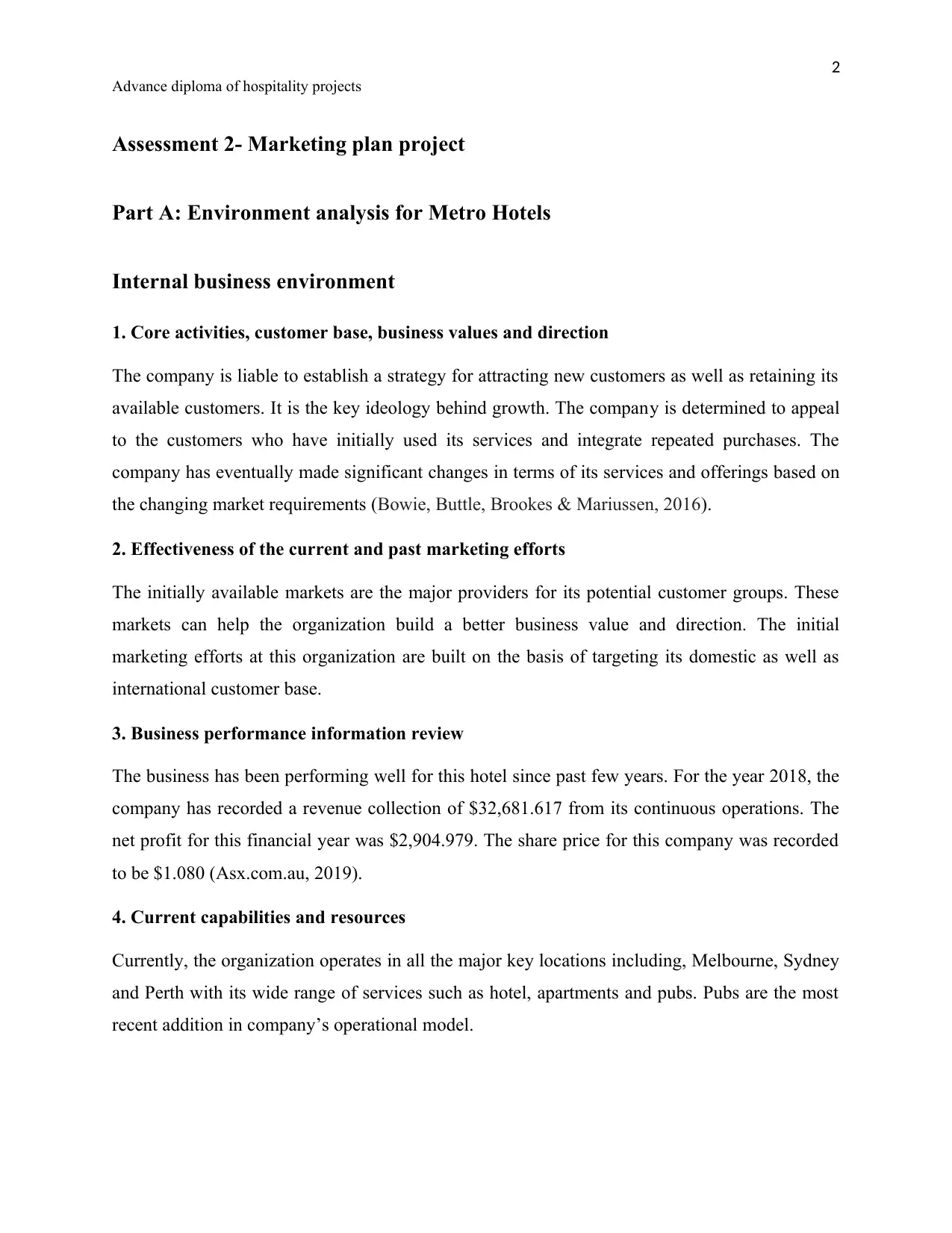
2
Advance diploma of hospitality projects
Assessment 2- Marketing plan project
Part A: Environment analysis for Metro Hotels
Internal business environment
1. Core activities, customer base, business values and direction
The company is liable to establish a strategy for attracting new customers as well as retaining its
available customers. It is the key ideology behind growth. The company is determined to appeal
to the customers who have initially used its services and integrate repeated purchases. The
company has eventually made significant changes in terms of its services and offerings based on
the changing market requirements (Bowie, Buttle, Brookes & Mariussen, 2016).
2. Effectiveness of the current and past marketing efforts
The initially available markets are the major providers for its potential customer groups. These
markets can help the organization build a better business value and direction. The initial
marketing efforts at this organization are built on the basis of targeting its domestic as well as
international customer base.
3. Business performance information review
The business has been performing well for this hotel since past few years. For the year 2018, the
company has recorded a revenue collection of $32,681.617 from its continuous operations. The
net profit for this financial year was $2,904.979. The share price for this company was recorded
to be $1.080 (Asx.com.au, 2019).
4. Current capabilities and resources
Currently, the organization operates in all the major key locations including, Melbourne, Sydney
and Perth with its wide range of services such as hotel, apartments and pubs. Pubs are the most
recent addition in company’s operational model.
Advance diploma of hospitality projects
Assessment 2- Marketing plan project
Part A: Environment analysis for Metro Hotels
Internal business environment
1. Core activities, customer base, business values and direction
The company is liable to establish a strategy for attracting new customers as well as retaining its
available customers. It is the key ideology behind growth. The company is determined to appeal
to the customers who have initially used its services and integrate repeated purchases. The
company has eventually made significant changes in terms of its services and offerings based on
the changing market requirements (Bowie, Buttle, Brookes & Mariussen, 2016).
2. Effectiveness of the current and past marketing efforts
The initially available markets are the major providers for its potential customer groups. These
markets can help the organization build a better business value and direction. The initial
marketing efforts at this organization are built on the basis of targeting its domestic as well as
international customer base.
3. Business performance information review
The business has been performing well for this hotel since past few years. For the year 2018, the
company has recorded a revenue collection of $32,681.617 from its continuous operations. The
net profit for this financial year was $2,904.979. The share price for this company was recorded
to be $1.080 (Asx.com.au, 2019).
4. Current capabilities and resources
Currently, the organization operates in all the major key locations including, Melbourne, Sydney
and Perth with its wide range of services such as hotel, apartments and pubs. Pubs are the most
recent addition in company’s operational model.
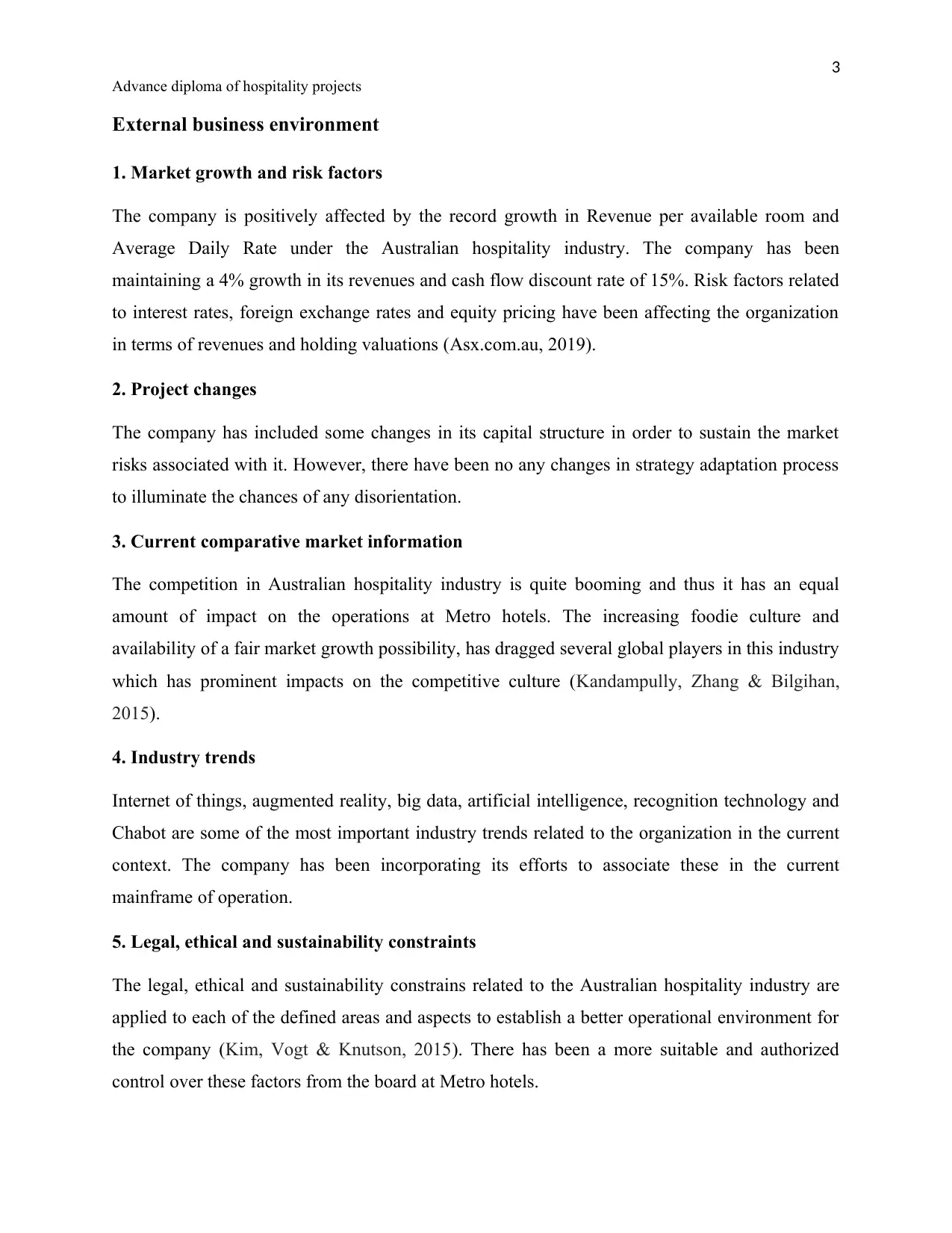
3
Advance diploma of hospitality projects
External business environment
1. Market growth and risk factors
The company is positively affected by the record growth in Revenue per available room and
Average Daily Rate under the Australian hospitality industry. The company has been
maintaining a 4% growth in its revenues and cash flow discount rate of 15%. Risk factors related
to interest rates, foreign exchange rates and equity pricing have been affecting the organization
in terms of revenues and holding valuations (Asx.com.au, 2019).
2. Project changes
The company has included some changes in its capital structure in order to sustain the market
risks associated with it. However, there have been no any changes in strategy adaptation process
to illuminate the chances of any disorientation.
3. Current comparative market information
The competition in Australian hospitality industry is quite booming and thus it has an equal
amount of impact on the operations at Metro hotels. The increasing foodie culture and
availability of a fair market growth possibility, has dragged several global players in this industry
which has prominent impacts on the competitive culture (Kandampully, Zhang & Bilgihan,
2015).
4. Industry trends
Internet of things, augmented reality, big data, artificial intelligence, recognition technology and
Chabot are some of the most important industry trends related to the organization in the current
context. The company has been incorporating its efforts to associate these in the current
mainframe of operation.
5. Legal, ethical and sustainability constraints
The legal, ethical and sustainability constrains related to the Australian hospitality industry are
applied to each of the defined areas and aspects to establish a better operational environment for
the company (Kim, Vogt & Knutson, 2015). There has been a more suitable and authorized
control over these factors from the board at Metro hotels.
Advance diploma of hospitality projects
External business environment
1. Market growth and risk factors
The company is positively affected by the record growth in Revenue per available room and
Average Daily Rate under the Australian hospitality industry. The company has been
maintaining a 4% growth in its revenues and cash flow discount rate of 15%. Risk factors related
to interest rates, foreign exchange rates and equity pricing have been affecting the organization
in terms of revenues and holding valuations (Asx.com.au, 2019).
2. Project changes
The company has included some changes in its capital structure in order to sustain the market
risks associated with it. However, there have been no any changes in strategy adaptation process
to illuminate the chances of any disorientation.
3. Current comparative market information
The competition in Australian hospitality industry is quite booming and thus it has an equal
amount of impact on the operations at Metro hotels. The increasing foodie culture and
availability of a fair market growth possibility, has dragged several global players in this industry
which has prominent impacts on the competitive culture (Kandampully, Zhang & Bilgihan,
2015).
4. Industry trends
Internet of things, augmented reality, big data, artificial intelligence, recognition technology and
Chabot are some of the most important industry trends related to the organization in the current
context. The company has been incorporating its efforts to associate these in the current
mainframe of operation.
5. Legal, ethical and sustainability constraints
The legal, ethical and sustainability constrains related to the Australian hospitality industry are
applied to each of the defined areas and aspects to establish a better operational environment for
the company (Kim, Vogt & Knutson, 2015). There has been a more suitable and authorized
control over these factors from the board at Metro hotels.
⊘ This is a preview!⊘
Do you want full access?
Subscribe today to unlock all pages.

Trusted by 1+ million students worldwide
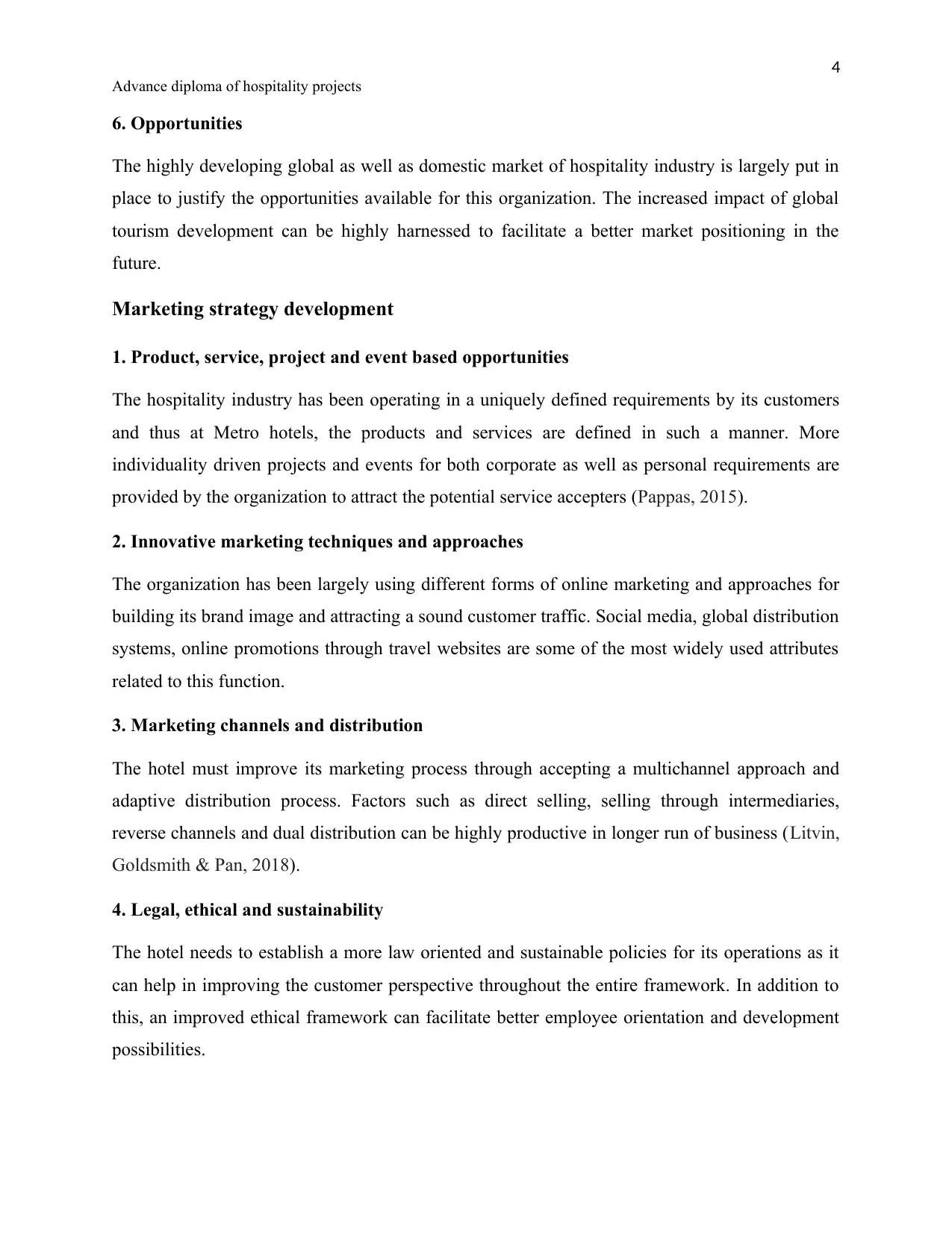
4
Advance diploma of hospitality projects
6. Opportunities
The highly developing global as well as domestic market of hospitality industry is largely put in
place to justify the opportunities available for this organization. The increased impact of global
tourism development can be highly harnessed to facilitate a better market positioning in the
future.
Marketing strategy development
1. Product, service, project and event based opportunities
The hospitality industry has been operating in a uniquely defined requirements by its customers
and thus at Metro hotels, the products and services are defined in such a manner. More
individuality driven projects and events for both corporate as well as personal requirements are
provided by the organization to attract the potential service accepters (Pappas, 2015).
2. Innovative marketing techniques and approaches
The organization has been largely using different forms of online marketing and approaches for
building its brand image and attracting a sound customer traffic. Social media, global distribution
systems, online promotions through travel websites are some of the most widely used attributes
related to this function.
3. Marketing channels and distribution
The hotel must improve its marketing process through accepting a multichannel approach and
adaptive distribution process. Factors such as direct selling, selling through intermediaries,
reverse channels and dual distribution can be highly productive in longer run of business (Litvin,
Goldsmith & Pan, 2018).
4. Legal, ethical and sustainability
The hotel needs to establish a more law oriented and sustainable policies for its operations as it
can help in improving the customer perspective throughout the entire framework. In addition to
this, an improved ethical framework can facilitate better employee orientation and development
possibilities.
Advance diploma of hospitality projects
6. Opportunities
The highly developing global as well as domestic market of hospitality industry is largely put in
place to justify the opportunities available for this organization. The increased impact of global
tourism development can be highly harnessed to facilitate a better market positioning in the
future.
Marketing strategy development
1. Product, service, project and event based opportunities
The hospitality industry has been operating in a uniquely defined requirements by its customers
and thus at Metro hotels, the products and services are defined in such a manner. More
individuality driven projects and events for both corporate as well as personal requirements are
provided by the organization to attract the potential service accepters (Pappas, 2015).
2. Innovative marketing techniques and approaches
The organization has been largely using different forms of online marketing and approaches for
building its brand image and attracting a sound customer traffic. Social media, global distribution
systems, online promotions through travel websites are some of the most widely used attributes
related to this function.
3. Marketing channels and distribution
The hotel must improve its marketing process through accepting a multichannel approach and
adaptive distribution process. Factors such as direct selling, selling through intermediaries,
reverse channels and dual distribution can be highly productive in longer run of business (Litvin,
Goldsmith & Pan, 2018).
4. Legal, ethical and sustainability
The hotel needs to establish a more law oriented and sustainable policies for its operations as it
can help in improving the customer perspective throughout the entire framework. In addition to
this, an improved ethical framework can facilitate better employee orientation and development
possibilities.
Paraphrase This Document
Need a fresh take? Get an instant paraphrase of this document with our AI Paraphraser
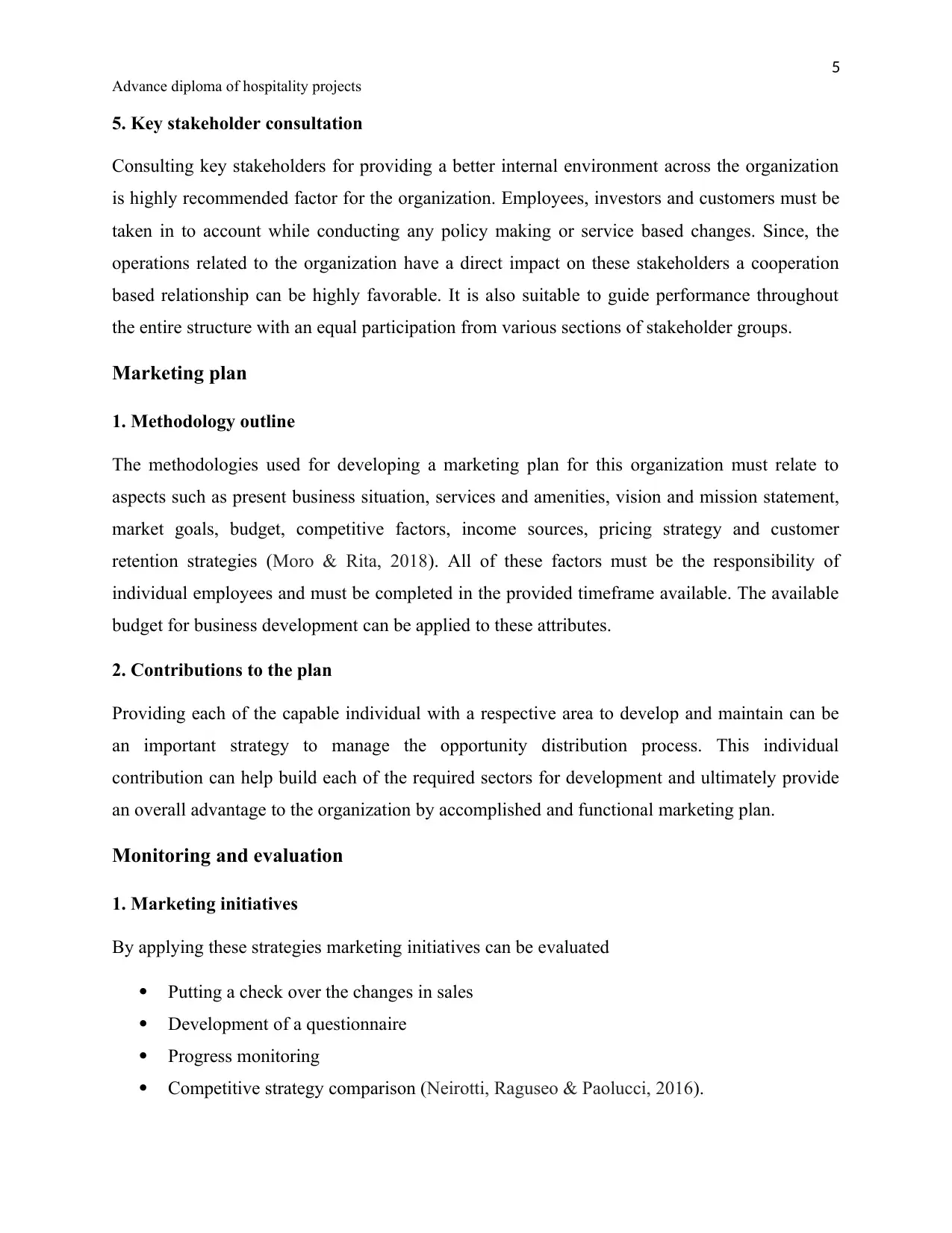
5
Advance diploma of hospitality projects
5. Key stakeholder consultation
Consulting key stakeholders for providing a better internal environment across the organization
is highly recommended factor for the organization. Employees, investors and customers must be
taken in to account while conducting any policy making or service based changes. Since, the
operations related to the organization have a direct impact on these stakeholders a cooperation
based relationship can be highly favorable. It is also suitable to guide performance throughout
the entire structure with an equal participation from various sections of stakeholder groups.
Marketing plan
1. Methodology outline
The methodologies used for developing a marketing plan for this organization must relate to
aspects such as present business situation, services and amenities, vision and mission statement,
market goals, budget, competitive factors, income sources, pricing strategy and customer
retention strategies (Moro & Rita, 2018). All of these factors must be the responsibility of
individual employees and must be completed in the provided timeframe available. The available
budget for business development can be applied to these attributes.
2. Contributions to the plan
Providing each of the capable individual with a respective area to develop and maintain can be
an important strategy to manage the opportunity distribution process. This individual
contribution can help build each of the required sectors for development and ultimately provide
an overall advantage to the organization by accomplished and functional marketing plan.
Monitoring and evaluation
1. Marketing initiatives
By applying these strategies marketing initiatives can be evaluated
Putting a check over the changes in sales
Development of a questionnaire
Progress monitoring
Competitive strategy comparison (Neirotti, Raguseo & Paolucci, 2016).
Advance diploma of hospitality projects
5. Key stakeholder consultation
Consulting key stakeholders for providing a better internal environment across the organization
is highly recommended factor for the organization. Employees, investors and customers must be
taken in to account while conducting any policy making or service based changes. Since, the
operations related to the organization have a direct impact on these stakeholders a cooperation
based relationship can be highly favorable. It is also suitable to guide performance throughout
the entire structure with an equal participation from various sections of stakeholder groups.
Marketing plan
1. Methodology outline
The methodologies used for developing a marketing plan for this organization must relate to
aspects such as present business situation, services and amenities, vision and mission statement,
market goals, budget, competitive factors, income sources, pricing strategy and customer
retention strategies (Moro & Rita, 2018). All of these factors must be the responsibility of
individual employees and must be completed in the provided timeframe available. The available
budget for business development can be applied to these attributes.
2. Contributions to the plan
Providing each of the capable individual with a respective area to develop and maintain can be
an important strategy to manage the opportunity distribution process. This individual
contribution can help build each of the required sectors for development and ultimately provide
an overall advantage to the organization by accomplished and functional marketing plan.
Monitoring and evaluation
1. Marketing initiatives
By applying these strategies marketing initiatives can be evaluated
Putting a check over the changes in sales
Development of a questionnaire
Progress monitoring
Competitive strategy comparison (Neirotti, Raguseo & Paolucci, 2016).
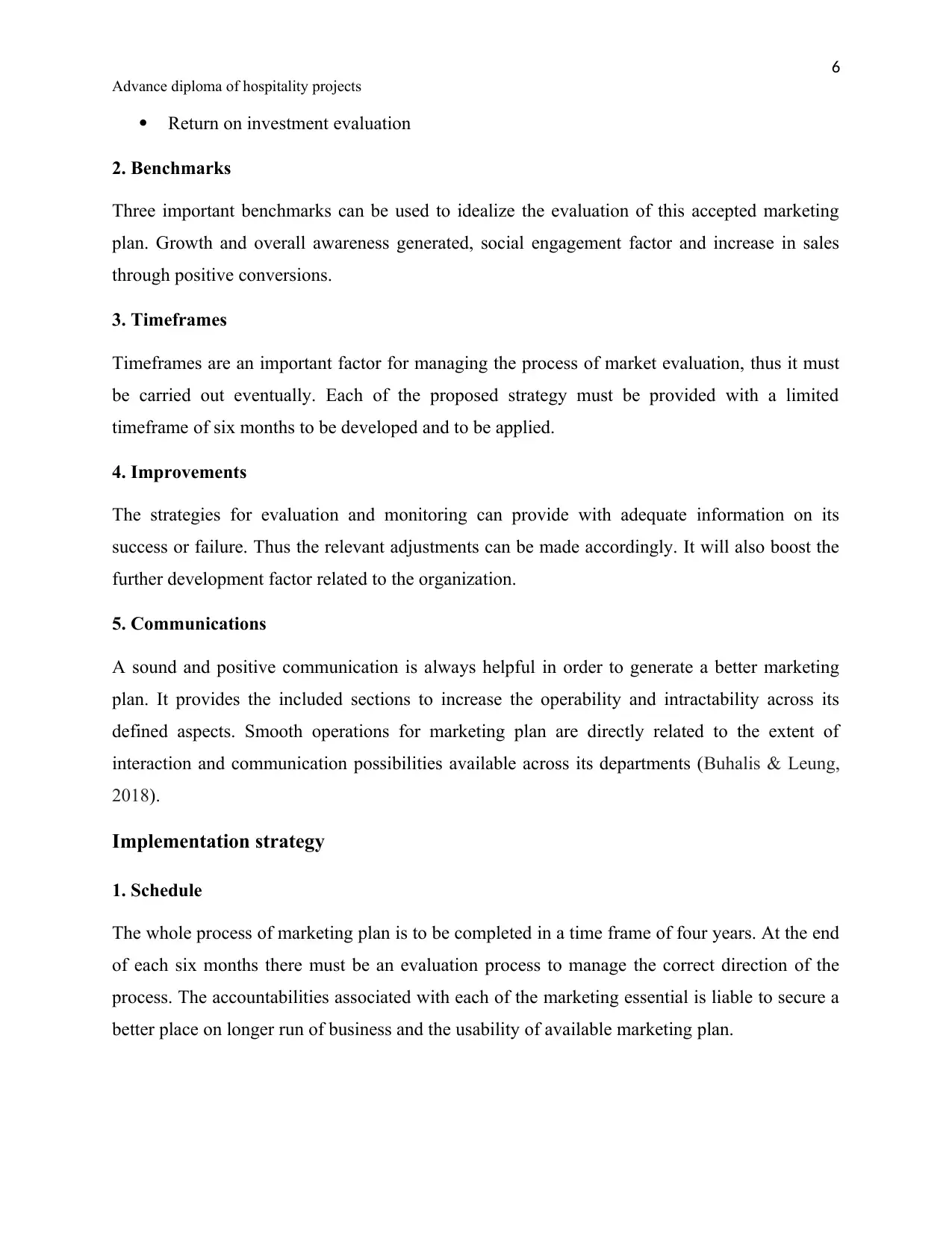
6
Advance diploma of hospitality projects
Return on investment evaluation
2. Benchmarks
Three important benchmarks can be used to idealize the evaluation of this accepted marketing
plan. Growth and overall awareness generated, social engagement factor and increase in sales
through positive conversions.
3. Timeframes
Timeframes are an important factor for managing the process of market evaluation, thus it must
be carried out eventually. Each of the proposed strategy must be provided with a limited
timeframe of six months to be developed and to be applied.
4. Improvements
The strategies for evaluation and monitoring can provide with adequate information on its
success or failure. Thus the relevant adjustments can be made accordingly. It will also boost the
further development factor related to the organization.
5. Communications
A sound and positive communication is always helpful in order to generate a better marketing
plan. It provides the included sections to increase the operability and intractability across its
defined aspects. Smooth operations for marketing plan are directly related to the extent of
interaction and communication possibilities available across its departments (Buhalis & Leung,
2018).
Implementation strategy
1. Schedule
The whole process of marketing plan is to be completed in a time frame of four years. At the end
of each six months there must be an evaluation process to manage the correct direction of the
process. The accountabilities associated with each of the marketing essential is liable to secure a
better place on longer run of business and the usability of available marketing plan.
Advance diploma of hospitality projects
Return on investment evaluation
2. Benchmarks
Three important benchmarks can be used to idealize the evaluation of this accepted marketing
plan. Growth and overall awareness generated, social engagement factor and increase in sales
through positive conversions.
3. Timeframes
Timeframes are an important factor for managing the process of market evaluation, thus it must
be carried out eventually. Each of the proposed strategy must be provided with a limited
timeframe of six months to be developed and to be applied.
4. Improvements
The strategies for evaluation and monitoring can provide with adequate information on its
success or failure. Thus the relevant adjustments can be made accordingly. It will also boost the
further development factor related to the organization.
5. Communications
A sound and positive communication is always helpful in order to generate a better marketing
plan. It provides the included sections to increase the operability and intractability across its
defined aspects. Smooth operations for marketing plan are directly related to the extent of
interaction and communication possibilities available across its departments (Buhalis & Leung,
2018).
Implementation strategy
1. Schedule
The whole process of marketing plan is to be completed in a time frame of four years. At the end
of each six months there must be an evaluation process to manage the correct direction of the
process. The accountabilities associated with each of the marketing essential is liable to secure a
better place on longer run of business and the usability of available marketing plan.
⊘ This is a preview!⊘
Do you want full access?
Subscribe today to unlock all pages.

Trusted by 1+ million students worldwide
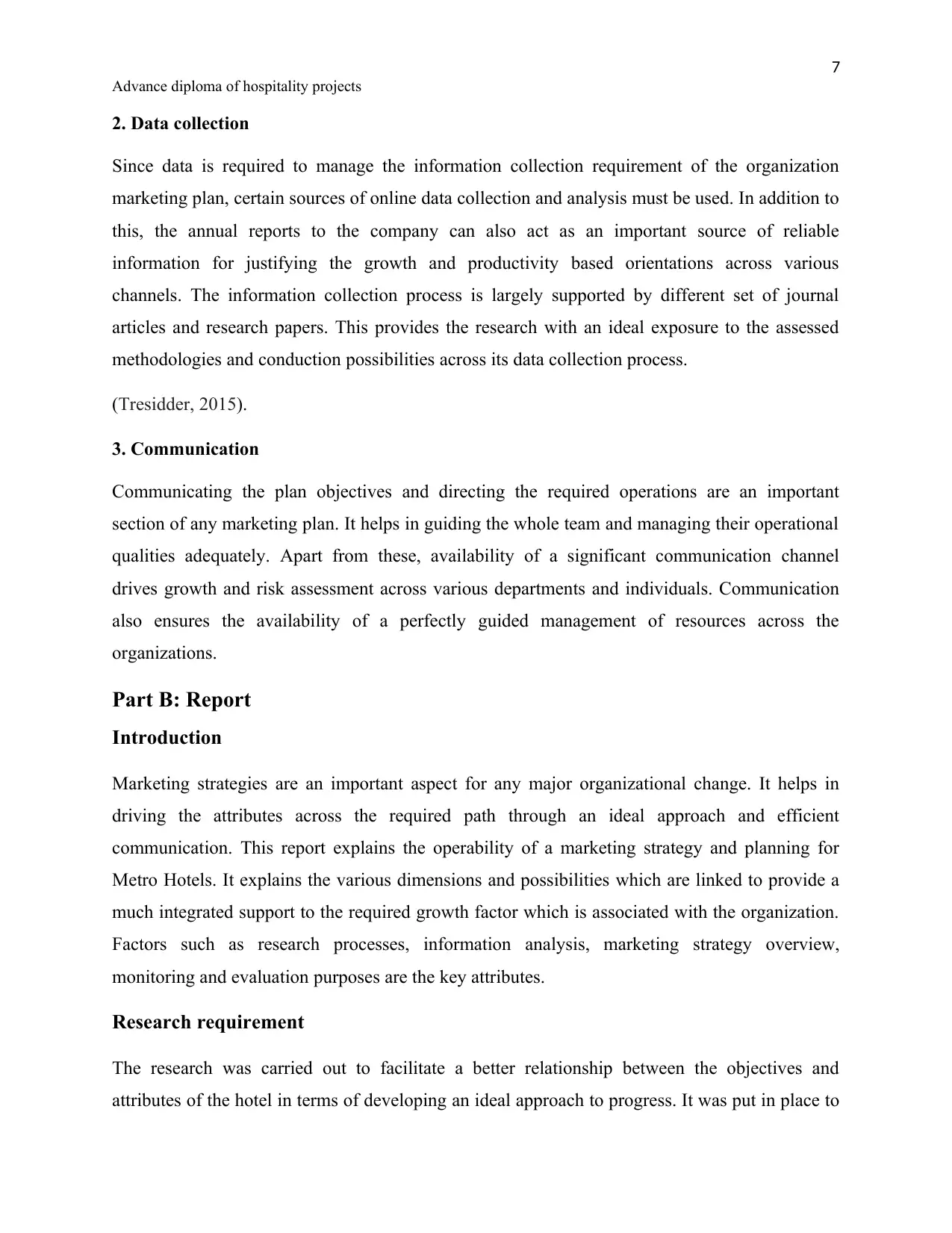
7
Advance diploma of hospitality projects
2. Data collection
Since data is required to manage the information collection requirement of the organization
marketing plan, certain sources of online data collection and analysis must be used. In addition to
this, the annual reports to the company can also act as an important source of reliable
information for justifying the growth and productivity based orientations across various
channels. The information collection process is largely supported by different set of journal
articles and research papers. This provides the research with an ideal exposure to the assessed
methodologies and conduction possibilities across its data collection process.
(Tresidder, 2015).
3. Communication
Communicating the plan objectives and directing the required operations are an important
section of any marketing plan. It helps in guiding the whole team and managing their operational
qualities adequately. Apart from these, availability of a significant communication channel
drives growth and risk assessment across various departments and individuals. Communication
also ensures the availability of a perfectly guided management of resources across the
organizations.
Part B: Report
Introduction
Marketing strategies are an important aspect for any major organizational change. It helps in
driving the attributes across the required path through an ideal approach and efficient
communication. This report explains the operability of a marketing strategy and planning for
Metro Hotels. It explains the various dimensions and possibilities which are linked to provide a
much integrated support to the required growth factor which is associated with the organization.
Factors such as research processes, information analysis, marketing strategy overview,
monitoring and evaluation purposes are the key attributes.
Research requirement
The research was carried out to facilitate a better relationship between the objectives and
attributes of the hotel in terms of developing an ideal approach to progress. It was put in place to
Advance diploma of hospitality projects
2. Data collection
Since data is required to manage the information collection requirement of the organization
marketing plan, certain sources of online data collection and analysis must be used. In addition to
this, the annual reports to the company can also act as an important source of reliable
information for justifying the growth and productivity based orientations across various
channels. The information collection process is largely supported by different set of journal
articles and research papers. This provides the research with an ideal exposure to the assessed
methodologies and conduction possibilities across its data collection process.
(Tresidder, 2015).
3. Communication
Communicating the plan objectives and directing the required operations are an important
section of any marketing plan. It helps in guiding the whole team and managing their operational
qualities adequately. Apart from these, availability of a significant communication channel
drives growth and risk assessment across various departments and individuals. Communication
also ensures the availability of a perfectly guided management of resources across the
organizations.
Part B: Report
Introduction
Marketing strategies are an important aspect for any major organizational change. It helps in
driving the attributes across the required path through an ideal approach and efficient
communication. This report explains the operability of a marketing strategy and planning for
Metro Hotels. It explains the various dimensions and possibilities which are linked to provide a
much integrated support to the required growth factor which is associated with the organization.
Factors such as research processes, information analysis, marketing strategy overview,
monitoring and evaluation purposes are the key attributes.
Research requirement
The research was carried out to facilitate a better relationship between the objectives and
attributes of the hotel in terms of developing an ideal approach to progress. It was put in place to
Paraphrase This Document
Need a fresh take? Get an instant paraphrase of this document with our AI Paraphraser
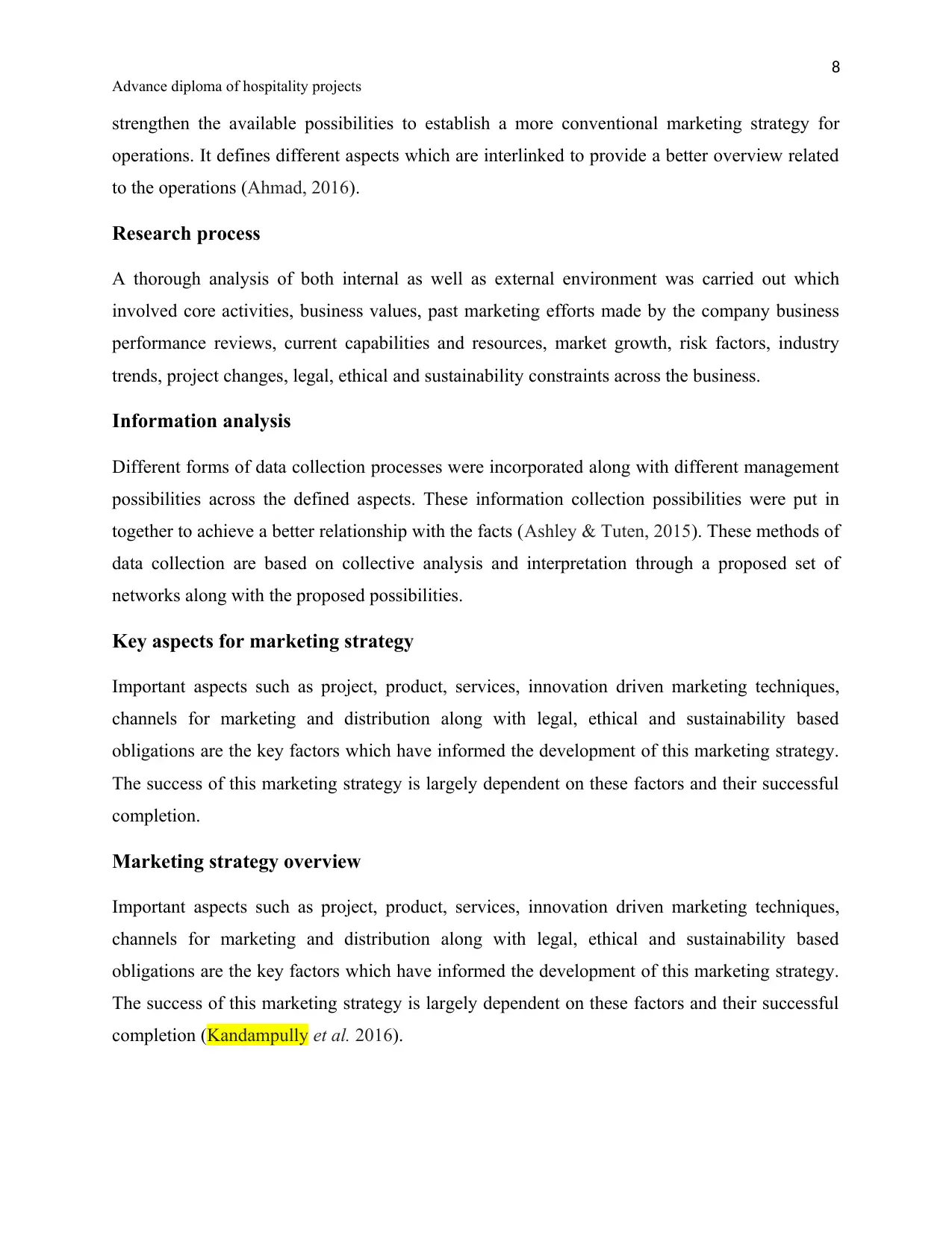
8
Advance diploma of hospitality projects
strengthen the available possibilities to establish a more conventional marketing strategy for
operations. It defines different aspects which are interlinked to provide a better overview related
to the operations (Ahmad, 2016).
Research process
A thorough analysis of both internal as well as external environment was carried out which
involved core activities, business values, past marketing efforts made by the company business
performance reviews, current capabilities and resources, market growth, risk factors, industry
trends, project changes, legal, ethical and sustainability constraints across the business.
Information analysis
Different forms of data collection processes were incorporated along with different management
possibilities across the defined aspects. These information collection possibilities were put in
together to achieve a better relationship with the facts (Ashley & Tuten, 2015). These methods of
data collection are based on collective analysis and interpretation through a proposed set of
networks along with the proposed possibilities.
Key aspects for marketing strategy
Important aspects such as project, product, services, innovation driven marketing techniques,
channels for marketing and distribution along with legal, ethical and sustainability based
obligations are the key factors which have informed the development of this marketing strategy.
The success of this marketing strategy is largely dependent on these factors and their successful
completion.
Marketing strategy overview
Important aspects such as project, product, services, innovation driven marketing techniques,
channels for marketing and distribution along with legal, ethical and sustainability based
obligations are the key factors which have informed the development of this marketing strategy.
The success of this marketing strategy is largely dependent on these factors and their successful
completion (Kandampully et al. 2016).
Advance diploma of hospitality projects
strengthen the available possibilities to establish a more conventional marketing strategy for
operations. It defines different aspects which are interlinked to provide a better overview related
to the operations (Ahmad, 2016).
Research process
A thorough analysis of both internal as well as external environment was carried out which
involved core activities, business values, past marketing efforts made by the company business
performance reviews, current capabilities and resources, market growth, risk factors, industry
trends, project changes, legal, ethical and sustainability constraints across the business.
Information analysis
Different forms of data collection processes were incorporated along with different management
possibilities across the defined aspects. These information collection possibilities were put in
together to achieve a better relationship with the facts (Ashley & Tuten, 2015). These methods of
data collection are based on collective analysis and interpretation through a proposed set of
networks along with the proposed possibilities.
Key aspects for marketing strategy
Important aspects such as project, product, services, innovation driven marketing techniques,
channels for marketing and distribution along with legal, ethical and sustainability based
obligations are the key factors which have informed the development of this marketing strategy.
The success of this marketing strategy is largely dependent on these factors and their successful
completion.
Marketing strategy overview
Important aspects such as project, product, services, innovation driven marketing techniques,
channels for marketing and distribution along with legal, ethical and sustainability based
obligations are the key factors which have informed the development of this marketing strategy.
The success of this marketing strategy is largely dependent on these factors and their successful
completion (Kandampully et al. 2016).
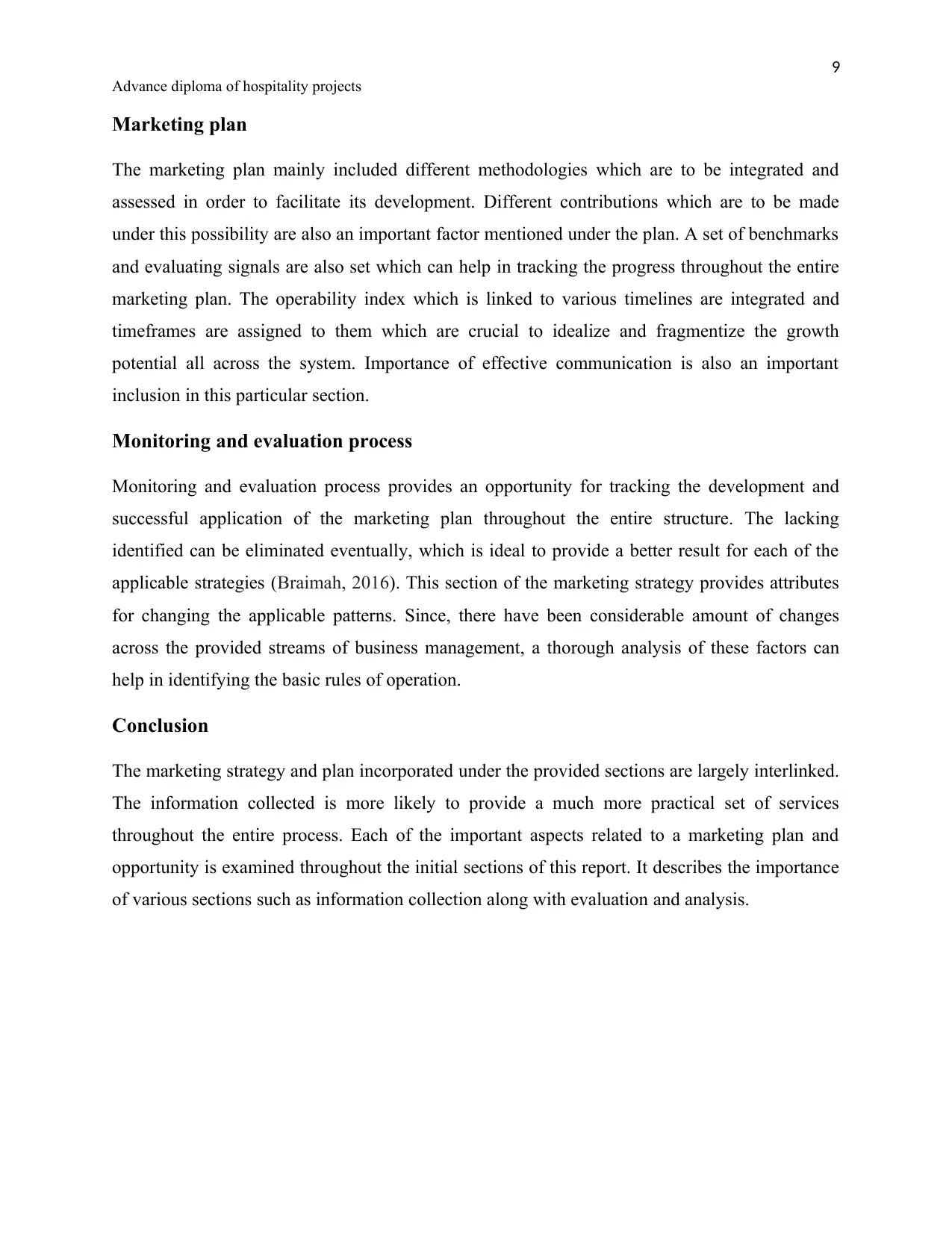
9
Advance diploma of hospitality projects
Marketing plan
The marketing plan mainly included different methodologies which are to be integrated and
assessed in order to facilitate its development. Different contributions which are to be made
under this possibility are also an important factor mentioned under the plan. A set of benchmarks
and evaluating signals are also set which can help in tracking the progress throughout the entire
marketing plan. The operability index which is linked to various timelines are integrated and
timeframes are assigned to them which are crucial to idealize and fragmentize the growth
potential all across the system. Importance of effective communication is also an important
inclusion in this particular section.
Monitoring and evaluation process
Monitoring and evaluation process provides an opportunity for tracking the development and
successful application of the marketing plan throughout the entire structure. The lacking
identified can be eliminated eventually, which is ideal to provide a better result for each of the
applicable strategies (Braimah, 2016). This section of the marketing strategy provides attributes
for changing the applicable patterns. Since, there have been considerable amount of changes
across the provided streams of business management, a thorough analysis of these factors can
help in identifying the basic rules of operation.
Conclusion
The marketing strategy and plan incorporated under the provided sections are largely interlinked.
The information collected is more likely to provide a much more practical set of services
throughout the entire process. Each of the important aspects related to a marketing plan and
opportunity is examined throughout the initial sections of this report. It describes the importance
of various sections such as information collection along with evaluation and analysis.
Advance diploma of hospitality projects
Marketing plan
The marketing plan mainly included different methodologies which are to be integrated and
assessed in order to facilitate its development. Different contributions which are to be made
under this possibility are also an important factor mentioned under the plan. A set of benchmarks
and evaluating signals are also set which can help in tracking the progress throughout the entire
marketing plan. The operability index which is linked to various timelines are integrated and
timeframes are assigned to them which are crucial to idealize and fragmentize the growth
potential all across the system. Importance of effective communication is also an important
inclusion in this particular section.
Monitoring and evaluation process
Monitoring and evaluation process provides an opportunity for tracking the development and
successful application of the marketing plan throughout the entire structure. The lacking
identified can be eliminated eventually, which is ideal to provide a better result for each of the
applicable strategies (Braimah, 2016). This section of the marketing strategy provides attributes
for changing the applicable patterns. Since, there have been considerable amount of changes
across the provided streams of business management, a thorough analysis of these factors can
help in identifying the basic rules of operation.
Conclusion
The marketing strategy and plan incorporated under the provided sections are largely interlinked.
The information collected is more likely to provide a much more practical set of services
throughout the entire process. Each of the important aspects related to a marketing plan and
opportunity is examined throughout the initial sections of this report. It describes the importance
of various sections such as information collection along with evaluation and analysis.
⊘ This is a preview!⊘
Do you want full access?
Subscribe today to unlock all pages.

Trusted by 1+ million students worldwide
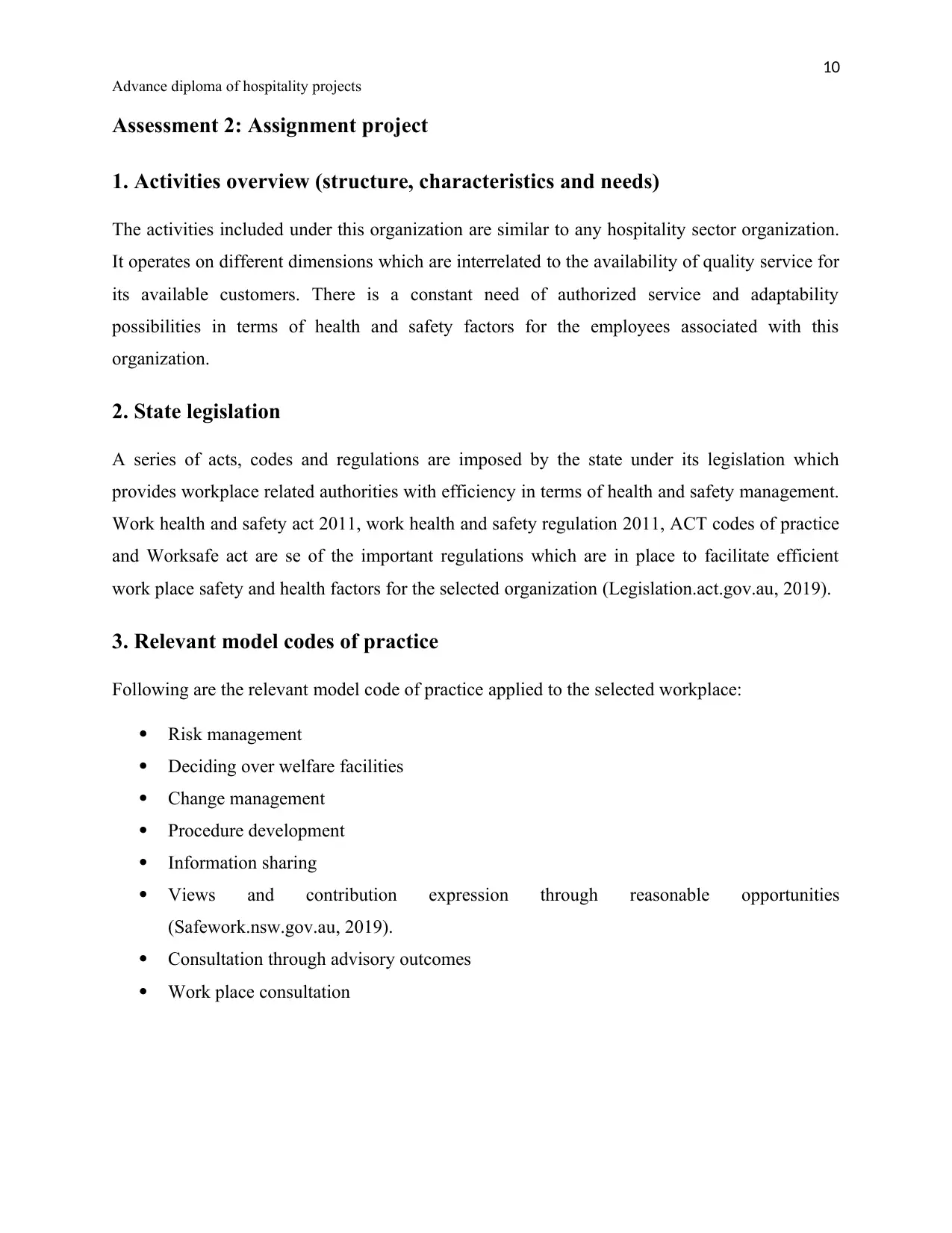
10
Advance diploma of hospitality projects
Assessment 2: Assignment project
1. Activities overview (structure, characteristics and needs)
The activities included under this organization are similar to any hospitality sector organization.
It operates on different dimensions which are interrelated to the availability of quality service for
its available customers. There is a constant need of authorized service and adaptability
possibilities in terms of health and safety factors for the employees associated with this
organization.
2. State legislation
A series of acts, codes and regulations are imposed by the state under its legislation which
provides workplace related authorities with efficiency in terms of health and safety management.
Work health and safety act 2011, work health and safety regulation 2011, ACT codes of practice
and Worksafe act are se of the important regulations which are in place to facilitate efficient
work place safety and health factors for the selected organization (Legislation.act.gov.au, 2019).
3. Relevant model codes of practice
Following are the relevant model code of practice applied to the selected workplace:
Risk management
Deciding over welfare facilities
Change management
Procedure development
Information sharing
Views and contribution expression through reasonable opportunities
(Safework.nsw.gov.au, 2019).
Consultation through advisory outcomes
Work place consultation
Advance diploma of hospitality projects
Assessment 2: Assignment project
1. Activities overview (structure, characteristics and needs)
The activities included under this organization are similar to any hospitality sector organization.
It operates on different dimensions which are interrelated to the availability of quality service for
its available customers. There is a constant need of authorized service and adaptability
possibilities in terms of health and safety factors for the employees associated with this
organization.
2. State legislation
A series of acts, codes and regulations are imposed by the state under its legislation which
provides workplace related authorities with efficiency in terms of health and safety management.
Work health and safety act 2011, work health and safety regulation 2011, ACT codes of practice
and Worksafe act are se of the important regulations which are in place to facilitate efficient
work place safety and health factors for the selected organization (Legislation.act.gov.au, 2019).
3. Relevant model codes of practice
Following are the relevant model code of practice applied to the selected workplace:
Risk management
Deciding over welfare facilities
Change management
Procedure development
Information sharing
Views and contribution expression through reasonable opportunities
(Safework.nsw.gov.au, 2019).
Consultation through advisory outcomes
Work place consultation
Paraphrase This Document
Need a fresh take? Get an instant paraphrase of this document with our AI Paraphraser
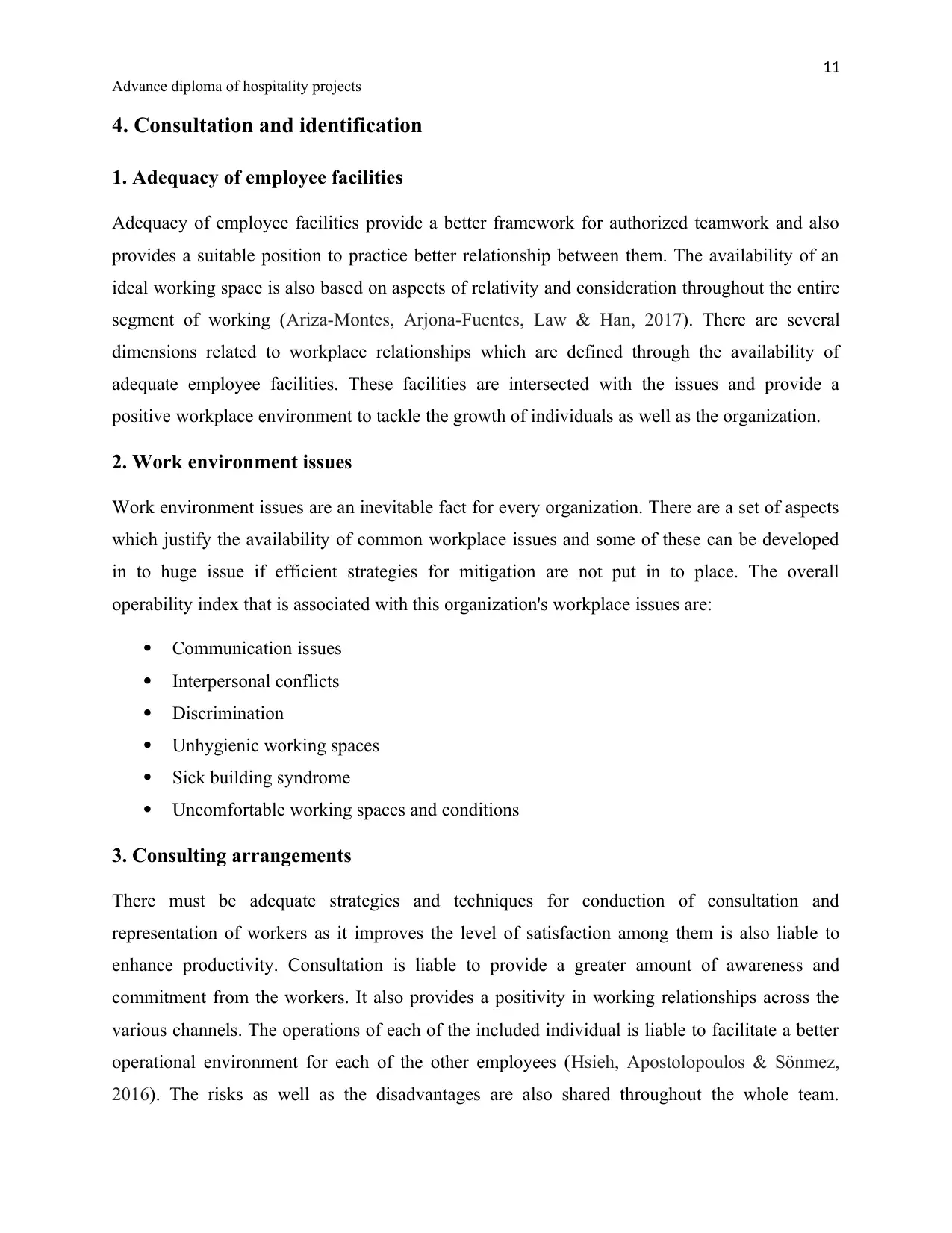
11
Advance diploma of hospitality projects
4. Consultation and identification
1. Adequacy of employee facilities
Adequacy of employee facilities provide a better framework for authorized teamwork and also
provides a suitable position to practice better relationship between them. The availability of an
ideal working space is also based on aspects of relativity and consideration throughout the entire
segment of working (Ariza-Montes, Arjona-Fuentes, Law & Han, 2017). There are several
dimensions related to workplace relationships which are defined through the availability of
adequate employee facilities. These facilities are intersected with the issues and provide a
positive workplace environment to tackle the growth of individuals as well as the organization.
2. Work environment issues
Work environment issues are an inevitable fact for every organization. There are a set of aspects
which justify the availability of common workplace issues and some of these can be developed
in to huge issue if efficient strategies for mitigation are not put in to place. The overall
operability index that is associated with this organization's workplace issues are:
Communication issues
Interpersonal conflicts
Discrimination
Unhygienic working spaces
Sick building syndrome
Uncomfortable working spaces and conditions
3. Consulting arrangements
There must be adequate strategies and techniques for conduction of consultation and
representation of workers as it improves the level of satisfaction among them is also liable to
enhance productivity. Consultation is liable to provide a greater amount of awareness and
commitment from the workers. It also provides a positivity in working relationships across the
various channels. The operations of each of the included individual is liable to facilitate a better
operational environment for each of the other employees (Hsieh, Apostolopoulos & Sönmez,
2016). The risks as well as the disadvantages are also shared throughout the whole team.
Advance diploma of hospitality projects
4. Consultation and identification
1. Adequacy of employee facilities
Adequacy of employee facilities provide a better framework for authorized teamwork and also
provides a suitable position to practice better relationship between them. The availability of an
ideal working space is also based on aspects of relativity and consideration throughout the entire
segment of working (Ariza-Montes, Arjona-Fuentes, Law & Han, 2017). There are several
dimensions related to workplace relationships which are defined through the availability of
adequate employee facilities. These facilities are intersected with the issues and provide a
positive workplace environment to tackle the growth of individuals as well as the organization.
2. Work environment issues
Work environment issues are an inevitable fact for every organization. There are a set of aspects
which justify the availability of common workplace issues and some of these can be developed
in to huge issue if efficient strategies for mitigation are not put in to place. The overall
operability index that is associated with this organization's workplace issues are:
Communication issues
Interpersonal conflicts
Discrimination
Unhygienic working spaces
Sick building syndrome
Uncomfortable working spaces and conditions
3. Consulting arrangements
There must be adequate strategies and techniques for conduction of consultation and
representation of workers as it improves the level of satisfaction among them is also liable to
enhance productivity. Consultation is liable to provide a greater amount of awareness and
commitment from the workers. It also provides a positivity in working relationships across the
various channels. The operations of each of the included individual is liable to facilitate a better
operational environment for each of the other employees (Hsieh, Apostolopoulos & Sönmez,
2016). The risks as well as the disadvantages are also shared throughout the whole team.
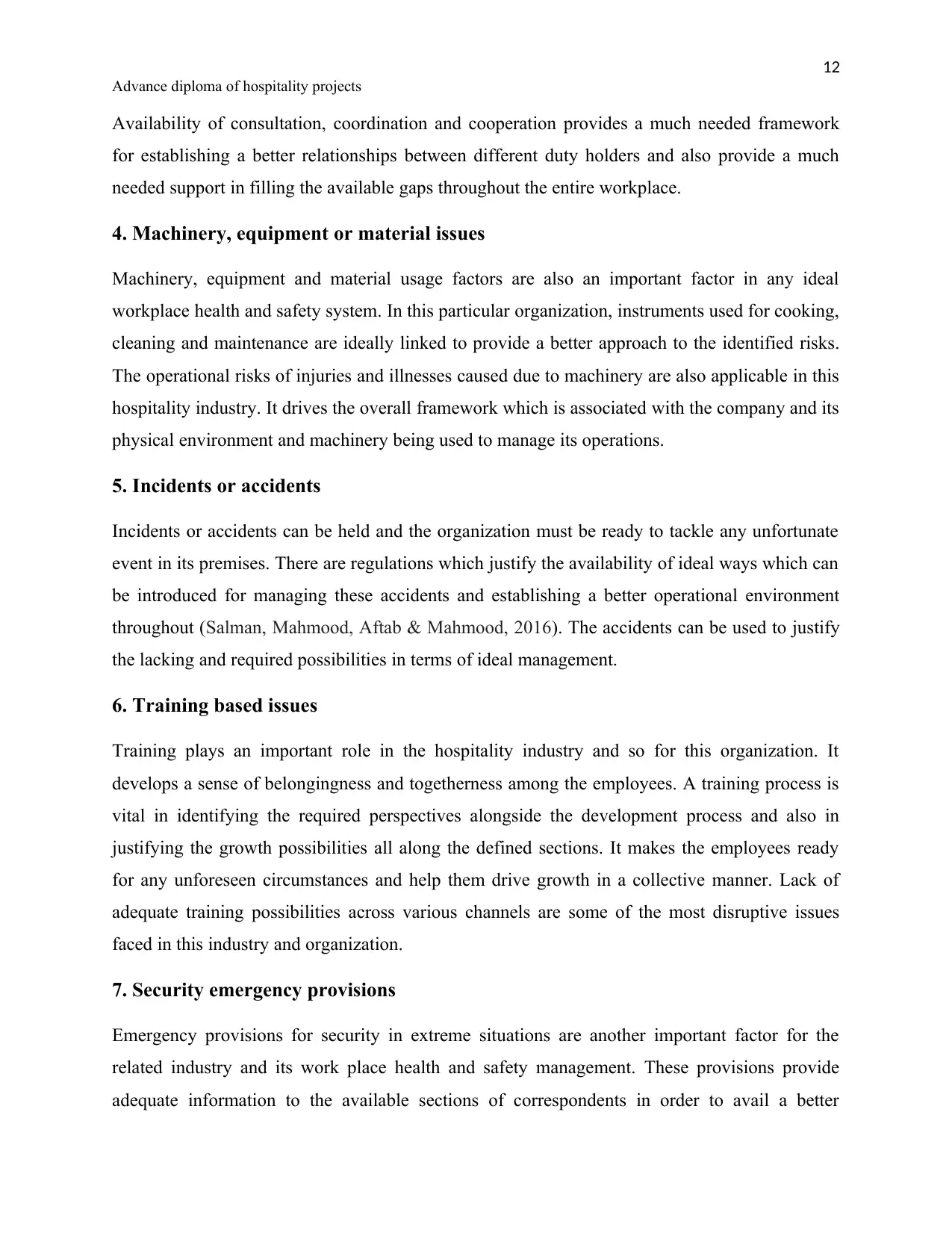
12
Advance diploma of hospitality projects
Availability of consultation, coordination and cooperation provides a much needed framework
for establishing a better relationships between different duty holders and also provide a much
needed support in filling the available gaps throughout the entire workplace.
4. Machinery, equipment or material issues
Machinery, equipment and material usage factors are also an important factor in any ideal
workplace health and safety system. In this particular organization, instruments used for cooking,
cleaning and maintenance are ideally linked to provide a better approach to the identified risks.
The operational risks of injuries and illnesses caused due to machinery are also applicable in this
hospitality industry. It drives the overall framework which is associated with the company and its
physical environment and machinery being used to manage its operations.
5. Incidents or accidents
Incidents or accidents can be held and the organization must be ready to tackle any unfortunate
event in its premises. There are regulations which justify the availability of ideal ways which can
be introduced for managing these accidents and establishing a better operational environment
throughout (Salman, Mahmood, Aftab & Mahmood, 2016). The accidents can be used to justify
the lacking and required possibilities in terms of ideal management.
6. Training based issues
Training plays an important role in the hospitality industry and so for this organization. It
develops a sense of belongingness and togetherness among the employees. A training process is
vital in identifying the required perspectives alongside the development process and also in
justifying the growth possibilities all along the defined sections. It makes the employees ready
for any unforeseen circumstances and help them drive growth in a collective manner. Lack of
adequate training possibilities across various channels are some of the most disruptive issues
faced in this industry and organization.
7. Security emergency provisions
Emergency provisions for security in extreme situations are another important factor for the
related industry and its work place health and safety management. These provisions provide
adequate information to the available sections of correspondents in order to avail a better
Advance diploma of hospitality projects
Availability of consultation, coordination and cooperation provides a much needed framework
for establishing a better relationships between different duty holders and also provide a much
needed support in filling the available gaps throughout the entire workplace.
4. Machinery, equipment or material issues
Machinery, equipment and material usage factors are also an important factor in any ideal
workplace health and safety system. In this particular organization, instruments used for cooking,
cleaning and maintenance are ideally linked to provide a better approach to the identified risks.
The operational risks of injuries and illnesses caused due to machinery are also applicable in this
hospitality industry. It drives the overall framework which is associated with the company and its
physical environment and machinery being used to manage its operations.
5. Incidents or accidents
Incidents or accidents can be held and the organization must be ready to tackle any unfortunate
event in its premises. There are regulations which justify the availability of ideal ways which can
be introduced for managing these accidents and establishing a better operational environment
throughout (Salman, Mahmood, Aftab & Mahmood, 2016). The accidents can be used to justify
the lacking and required possibilities in terms of ideal management.
6. Training based issues
Training plays an important role in the hospitality industry and so for this organization. It
develops a sense of belongingness and togetherness among the employees. A training process is
vital in identifying the required perspectives alongside the development process and also in
justifying the growth possibilities all along the defined sections. It makes the employees ready
for any unforeseen circumstances and help them drive growth in a collective manner. Lack of
adequate training possibilities across various channels are some of the most disruptive issues
faced in this industry and organization.
7. Security emergency provisions
Emergency provisions for security in extreme situations are another important factor for the
related industry and its work place health and safety management. These provisions provide
adequate information to the available sections of correspondents in order to avail a better
⊘ This is a preview!⊘
Do you want full access?
Subscribe today to unlock all pages.

Trusted by 1+ million students worldwide
1 out of 20
Related Documents
Your All-in-One AI-Powered Toolkit for Academic Success.
+13062052269
info@desklib.com
Available 24*7 on WhatsApp / Email
![[object Object]](/_next/static/media/star-bottom.7253800d.svg)
Unlock your academic potential
Copyright © 2020–2025 A2Z Services. All Rights Reserved. Developed and managed by ZUCOL.





